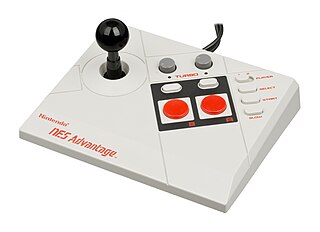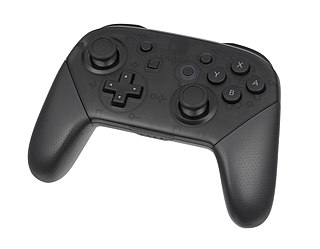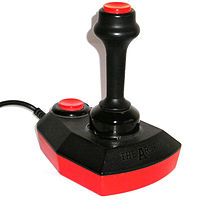
The Fairchild Channel F, short for "Channel Fun", is a home video game console, the first to be based on a microprocessor and to use ROM cartridges instead of having games built-in. It was released by Fairchild Camera and Instrument in November 1976 across North America at a retail price of US$169.95. It was launched as the "Video Entertainment System", but Fairchild rebranded their console as "Channel F" the next year while keeping the Video Entertainment System descriptor.

A joystick, sometimes called a flight stick, is an input device consisting of a stick that pivots on a base and reports its angle or direction to the device it is controlling. Also known as the control column, it is the principal control device in the cockpit of many civilian and military aircraft, either as a centre stick or side-stick. It has various switches to control functions of the aircraft controlled by the Pilot and First Officer of the flight.

A game controller, gaming controller, or simply controller, is an input device or input/output device used with video games or entertainment systems to provide input to a video game. Input devices that have been classified as game controllers include keyboards, mice, gamepads, and joysticks, as well as special purpose devices, such as steering wheels for driving games and light guns for shooting games. Controllers designs have evolved to include directional pads, multiple buttons, analog sticks, joysticks, motion detection, touch screens and a plethora of other features.

Microsoft SideWinder is a former brand name for a family of video gaming peripherals developed by Microsoft for PCs. It was initially marketed from 1995 to 2003 consisting of game controllers, then again from 2007 until the early 2010s with gaming mice and keyboards.

The NES Advantage is an arcade style controller manufactured by Asciiware and released by Nintendo for the Nintendo Entertainment System in 1987. The device is meant to rest on a flat surface at a comfortable level, such as a tabletop or the floor, with the player seated behind it. This way, it can be used like an arcade game joystick—with the left hand using the joystick and the right hand operating the buttons.

Track & Field, also known as Hyper Olympic in Japan and Europe, is an Olympic-themed sports video game developed by Konami and released as an arcade video game in 1983. The Japanese release featured an official license for the 1984 Summer Olympics. In Europe, the game was initially released under the Japanese title Hyper Olympic in 1983, before being re-released under the US title Track & Field in early 1984.

A gamepad is a type of video game controller held in two hands, where the fingers are used to provide input. They are typically the main input device for video game consoles.

Nekketsu Kōha Kunio-kun, released as Renegade in the West, is a beat 'em up video game developed by Technōs Japan and distributed by Taito for the arcades in 1986. In the original Japanese version Nekketsu Kōha Kunio-kun, the game revolves around a high-school delinquent named Kunio-kun who must stand up against a series of rival gangs frequently targeting his classmate Hiroshi. In the Western version Renegade, the player controls a street brawler who must face four different gangs in order to rescue his girlfriend being held captive by a mob boss.

A D-pad is a directional input method developed for video games. The flat plastic top is typically operated by a person's thumb. The plastic rests on four internal switches, each functioning like a push-button. When a person presses a direction on the D-Pad, it will press down one of the switches or press down two of the switches, offering eight total directions at 45-degree intervals. Most D-Pads contain a hard pivot beneath the center of the plastic. This pivot will prevent the plastic from being pressed onto all four buttons and will cause it to tilt in the direction pressed.

An arcade controller is a collective set of input devices designed primarily for use in an arcade cabinet. A typical control set consists of a joystick and a number of push-buttons. Less common setups include devices such as trackballs or steering wheels. These devices are generally produced under the assumption that they will be used in commercial settings, such as in video arcades, where they may be heavily or roughly used. Durability is one of the distinguishing characteristics of "authentic" arcade parts when compared with numerous, low-cost arcade imitations designed for private use in the home.
The Atari 2700 is a prototype home video game console that was developed by Atari, Inc. to be a wirelessly controlled version of Atari's popular Atari 2600 system. Intended for release in 1981, the 2700 was one of several planned follow-ups to the 2600, but the system was never put into full production. While It is unclear how many of these systems exist, former Atari employee Dan Kramer has stated that at least 12 consoles were made, plus extra controllers.

The Totally Accurate Controller MK2 (TAC-2) is an Atari 2600-compatible digital joystick game controller. It was commonly used with 1980s microcomputers such as the TI-99/4A, Atari 8-bit computers, Atari ST, Commodore 64 and Amiga. It was manufactured by Suncom in Illinois.

Forgotten Worlds, originally titled Lost Worlds, is a 1988 side-scrolling shooter video game developed and published by Capcom for arcades. It is notable for being the first title released by Capcom for their CP System arcade game hardware.

The Nintendo 64 controller is the standard game controller for the Nintendo 64 home video game console. It was first manufactured and released by Nintendo on June 23, 1996, in Japan; in September 29, 1996, in North America; and March 1, 1997, in Europe. It is the successor to the Super Nintendo controller and is designed in an "M" shape and features 10 buttons, a "Control Stick", and a D-pad.

The Atari 2600 hardware was based on the MOS Technology 6507 chip, offering a maximum resolution of 160 x 192 pixels (NTSC), 128 colors, 128 bytes of RAM with 4 KB on cartridges. The design experienced many makeovers and revisions during its 14-year production history, from the original "heavy sixer" to the Atari 2600 Jr. at the end. The system also has many controllers and third-party peripherals.

The Atari joystick port is a computer port used to connect various gaming controllers to game console and home computer systems in the 1970s to the 1990s. It was originally introduced on the Atari 2600 in 1977 and then used on the Atari 400 and 800 in 1979. It went cross-platform with the VIC-20 in 1981, and was then used on many following machines from both companies, as well as a growing list of 3rd party machines like the MSX platform and various Sega consoles.

The Atari CX40 joystick was the first widely used cross-platform game controller. The original CX10 was released with the Atari Video Computer System in 1977 and became the primary input device for most games on the platform. The CX10 was replaced after a year by the simpler and less expensive CX40. The addition of the Atari joystick port to other platforms cemented its popularity. It was the standard for the Atari 8-bit computers and was compatible with the VIC-20, Commodore 64, Commodore 128, MSX, and later the Atari ST and Amiga. Third-party adapters allowed it to be used on other systems, such as the Apple II, Commodore 16, TI-99/4A, and the ZX Spectrum.
Twin-stick shooter is a subgenre of shoot 'em up video games. It is a multidirectional shooter in which the player character is controlled using two joysticks: the first for movement on a flat plane and the second to shoot in the direction the joystick is pushed. Usually shots are fired as soon as the second joystick is moved, but in some games there is an additional button which must be held. Keyboard and mouse or touch input may supplant one or both joysticks. A few games, such as 1981's Vanguard, don't have a second joystick for shooting, but provide four buttons arranged in a diamond to fire in the cardinal directions.
















